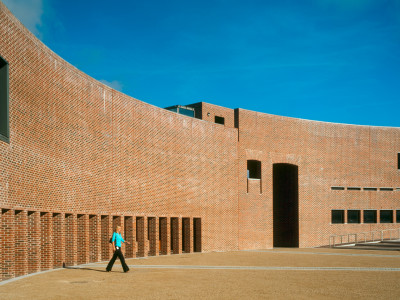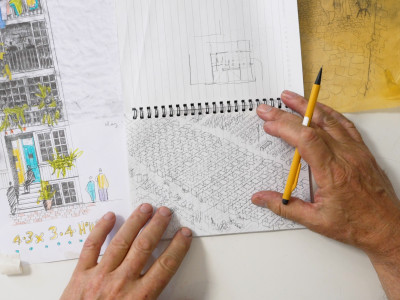
12 of the most iconic public spaces
By Helena Cuss
Published on 18 January 2016
Every day, public places around the world are used by ordinary people to exercise their rights. We look at four general "spaces of freedom" and their most famous examples.
Our recent architecture season focused on "spaces of freedom" – those ordinary, public places inhabited every day by ordinary people – and how these spaces can become extraordinary when they’re used to express civil, political and intellectual rights.
But, when many public spaces are actually privately owned and fitted out with CCTV cameras to monitor our behaviour in them, are any areas in the built environment truly free? How would you define a "space of freedom"? We’ve identified four different public place typologies which people have used throughout history to fight for their rights. Check out these famous examples and decide which of them, if any, you think are really "free" spaces.
The square
The public square has historically provided an ideal space for protest and demonstration – enclosed, often laden with iconic national or civic semiotics and purposely built for ceremonial use or large gatherings.
Tiananmen Square, Beijing
Built at the entrance to the Forbidden City in 1651, this space was enlarged by Chairman Mao in the 1950s to accommodate large-scale rallies. This purpose took a sinister turn in 1989 when a student-led occupation of one million protestors – calling for government accountability and freedom of speech – turned into a massacre by the military. Now frequently used as a military parade ground and heavily monitored by policeman conducting bag searches, today this space represents the tension between the forces of freedom, and state-sponsored cultural hegemony and political repression.
Trafalgar Square, London
This central London square has served as a stomping ground for discontented citizens since its construction in 1840. It has been the site of some of our most important demonstrations, from the 1848 Chartist rally for social reform, the 1958 Campaign for Nuclear Disarmament March, anti-apartheid protests in the 1980s and recent protests against wars in Afghanistan and Iraq.
Tahrir Square, Cairo
In January 2011, 50,000 people gathered in “Liberation Square” to peacefully protest against President Mubarak’s anti-democratic regime; by 1 February the numbers had swelled to a reported one million, and Mubarak was removed from power several days later. In 2013, history repeated itself when millions of civilians occupied the square again to demonstrate against President Morsi, ending in a coup d’etat by the military. In many ways, Tahrir Square has become an active participant in Egypt’s revolutionary politics and struggle for democracy.
The university
Almost a byword for freedom itself, the university may not constitute one particular place type, but is more a conceptual and psychological space in which young minds have pushed the boundaries of intellectual, civic and political freedoms, sometimes even in the face of violence.

California University Berkeley; Columbia University; Kent University
In the 1960s, students all over America were seized with revolutionary fervour and pacifist ideals, instigating protests against the Vietnam War and for the Civil Rights and Free Speech Movements. At UC Berkeley, student defiance against bans on campus-led political activity culminated in the 1965 Vietnam Day march, marking the first large scale protest against the Vietnam War. In 1968 Columbia University students staged furious protests when they discovered that the university administration was supporting US activity in Vietnam, and equally that they were planning on building a segregated gym on university land. At Kent State University in 1970, unarmed students were shot whilst protesting against the news of American military action in Cambodia. Four million students went on strike in retaliation, causing the closure of hundreds of universities and schools. A decade of student activism played a significant role in turning public opinion against the Vietnam War and its subsequent finish.
Athens Polytechnic
In 1973 Greek students demonstrating against the dictatorial military junta occupied Athens Polytechnic, and sent a radio broadcast across the city calling for civilians to join them, who answered in their thousands. Several days later tanks arrived outside the university, and student pleas for permission to evacuate were disregarded. In the ensuing violence 24 people died and hundreds were injured. One year later the junta had been defeated and Greece democracy was restored.
South African universities
In October 2015, students at South Africa’s top universities, led by Johannesburg’s University of the Witwatersrand, faced riot police, tear gas and stun grenades to protest against rising tuition fees, in the largest numbers since the end of apartheid in 1994. Many feel that the increase will make university unaffordable for poor and middle-class black South Africans, echoing the discriminatory economic imbalance still felt by many to exist in South African society.
The park
Another communal space, albeit with a much greater sense of physical freedom, the park was in the 20th century used as a site for positive change and non-violent protest.
St Peter’s Field, Manchester
A croft near Manchester became famous on 16 August 1819 when cavalry charged into a crowd of 80,000 civilians, who had gathered to agitate for parliamentary reform. Political radicalism had been building since the end of the Napoleonic wars in 1815 in reaction to chronic unemployment and poor economic conditions in Northern England. With 15 people killed and 400-700 injured, the incident was named the Peterloo Massacre in ironic comparison to the recent Battle of Waterloo. At the time, it was one of the biggest meetings to have taken place in Great Britain.
National Mall, Washington DC
This long park at the heart of the capital, stretching from the Washington Monument to the Lincoln Memorial was historically a popular site for rallies and protests. Its synonymy with American politics, democracy and civil rights was cemented with the 1963 March on Washington for Jobs and Freedom, when Martin Luther King delivered his iconic I Have a Dream speech from the Lincoln Memorial. The march prompted the passing of the Civil Rights Act in 1964 which outlawed and ended legal racial segregation.
Greenham Common, Berkshire
An unassuming green space and former RAF station in one of England’s tranquil Home Counties became the scene of bitter struggles between politicians and civilians in 1982, after the government decided to base cruise missiles there. In May, 250 women established a peace camp there to protest against nuclear warfare, and repeated attempts to evict them throughout the year simply led to the camp being rebuilt nearby. The last missiles left the camp in 1991, but the camp remained until 2000 to protest the UK trident programme.
The streets
Their very purpose being to convey movement, the network of pathways which runs through every city is a ready-made space for freedom marches and expansive demonstrations. They have played host to some of the most iconic freedom movements of modern times.

Pride March, New York City
Now held annually in countries worldwide and possibly the best-known rights march in history, the Pride movement was born in the streets of Manhattan in 1969. After the police raided the Stonewall Inn, a popular haunt in Greenwich Village for gay, lesbian and trans-gender people, riots and violent protests erupted in the surrounding neighbourhood. Within six months activist organisations were cohesive enough to arrange the first ever Gay Pride marches, which took place on 28 June, 1970, in New York, LA and San Francisco.
Notting Hill Carnival, London
Carnival may nowadays be best known as London’s biggest and best street party, but it is rooted in the 1950s struggle of West Indian immigrants, trying to carve out a space for their culture amongst rising racial violence in the Notting Hill area of West London. The first “Caribbean Carnival” was held in St Pancras Town Hall in reaction to the Notting Hill Race Riots in 1958, and by 1966 had burst out into the streets, filling them with celebrations of cultural unity and the sounds of Caribbean music which could be heard throughout the area. Riots during the 1970s – in which Caribbean youths were targeted and harassed by police – failed to quash the event, which nowadays offers free space to celebrate London’s multicultural diversity.
Berlin Wall
The Berlin Wall was famously constructed to stop migration from the Communist Eastern Bloc to Western Europe, restricting not just literal freedom of movement, but also binding East Berliners to an intellectually and politically repressive regime. Since the toppling of Communism in 1989 the remaining parts of the Wall which thread throughout Berlin’s streets have served as a permanent physical reminder in of the hard-won, irrepressible victory of personal and political freedoms, expressed through the colourful street art that now covers the concrete.
Related articles

Crunch: inside the first Architecture Window display
14 February 2024

RA Architecture Prize Winner 2023: Shane de Blacam
1 September 2023




